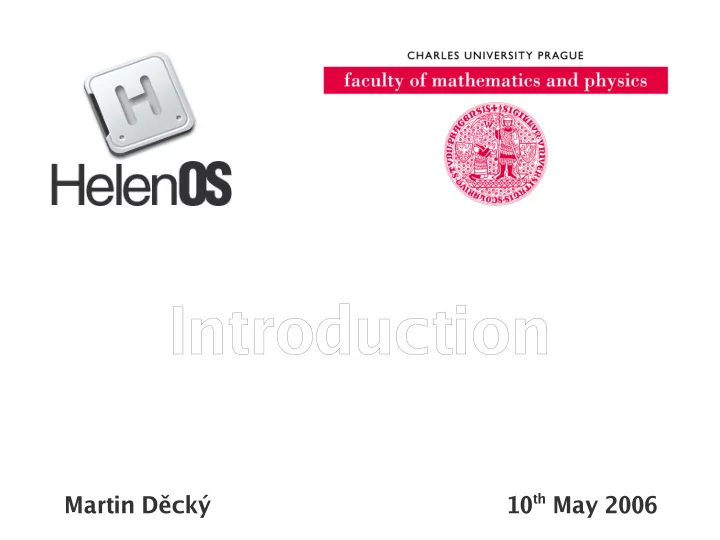

Intr troduction Martin Děcký 10 th May 2006
HelenOS Project HelenOS Project Experimental development operating system http://www.helenos.eu/ C, assembly Multiplatform IA-32, IA-64, AMD64, MIPS (32), Sparc V9 (64), PowerPC (32, 64) SMP support “Monolithic micro-kernel” BSD license
Motivations Motivations Understand the design of an OS From the bottom: synchronization, memory management, exceptions, linkage, booting, etc. From the top: subsystems and interfaces design Understand the whole system Testbed for experimental ideas Easy to port, easy to enhance, easy to rewrite Try to figure out new paradigms (files objects, drivers methods of tasks, etc.) Understand other interactions Compilers, boot loaders, emulators/simulators
Brief History Brief History 2001 – 2004 SPARTAN kernel developed by Jakub Jermar (IA-32) SMP support on IA-32 Late 2003 Port of SPARTAN to MIPS Late 2004 A team software project at Faculty of Mathematics and Physics (six developers, one senior supervisor) First specification 2005 Kernel work ● Ports to IA-64, AMD64, Sparc and PowerPC
Current Status Current Status Kernel Full functionality according the specs on all platforms Ability to host user space on all platforms User space Preliminary syscall API, a few basic C functions Support for kernel-managed threads and user- managed (pseudo) threads IPC framework (messages, shared memory) Preliminary user space driver interface
Current Status (2) Current Status (2)
Architecture Architecture
Kernel Subsystems Kernel Subsystems Physical memory management Buddy system atop of frame zones (self-contained) Slab allocator Virtual memory management Generic interface for address space management ● Page Table (4-level) instance, Global Hash Table instance ● TLB interface ● User address space divided into areas Time management Preemptive scheduling Generic timeout interface
Kernel Subsystems (2) Kernel Subsystems (2) Synchronization Spin-lock ● On non-SMP systems just disabling preemption ● Some ability to detect deadlocks Wait queue ● Basic passive primitive, threads waiting for an event Semaphore, mutex, condition variable, RW lock, futex Scheduler Round-robin with multiple priority queues Each CPU has his own queues, load-balancing thread Lazy FPU context switching (if supported by HW) Task management (common address space)
Kernel Subsystems (3) Kernel Subsystems (3) Interrupt/Exception handling mechanism Syscalls, IPC Device drivers interface, Capabilities control Covered in detail later Minor subsystems Boot infrastructure Data structures ● Bitmap, B+ tree, chained hash table, lists, fifo ELF loader String, sort functions, printf(), debug macros Kernel symbol table Kernel console ● Mostly for debugging purposes
User Space User Space libc Basic standard C functions and types ● Environment functions (__main, __exit, etc.) ● malloc, free (atop of AS areas) ● puts, printf and other I/O ● memcpy, strlen, etc. HelenOS specific Thread management ● Kernel-managed & user-managed threads (psthreads) Capabilities Synchronization ● Futexes Softint, softfloat
IPC IPC Unidirectional communication Phones ● Identifies starting point (as file descriptor) ● Phone 0 connected to Naming Service task ● call_sync , call_async Answerbox ● Receives messages ( wait_for_call ) – 4 native integers (method, 3 arguments) – Answer expected by answer (return value, 3 arguments) Synchronous messages ● call_sync blocks ● Returns the given answer
IPC (2) IPC (2) Asynchronous messages ● call_async never blocks – Fixed buffer in kernel, dynamic in user space – Registers callback ● Answer received in wait_for_call – Answers have higher priority than calls – Runs callback Connections ● connect_me_to – Client initiated connection ● accept/refuse ● forward (initially used by Naming Service) ● connect_to_me – Server initiated connection
IPC (3) IPC (3) 1 st phase 0 0 ns app driver 2 nd phase 0 0 ns app driver connect_to_me
IPC (4) IPC (4) 3 rd phase 0 0 ns app driver connect_me_to 4 th phase 0 0 ns app driver
DDI DDI User space hardware drivers Task needs special capabilities Map physical memory into AS Map I/O space (mostly IA-32 specific) Control preemption Receive messages upon interrupt ● Simple stateless language for handling level-triggered interrupts in kernel Drivers and clients communicate using IPC ● Keyboard driver ● Framebuffer driver ● Early PCI driver
Boot Process Boot Process Hardware-dependent boot stages Boot loader, loading of initial user space tasks into memory, bootstraping Hardware-dependent initialization CPUs, memory, exceptions, interrupts, drivers, etc. Generic initialization Buddy system, slab allocator Main kernel thread, load-balancing thread Initial user space tasks init (tests, capability manager) ns (IPC naming service) pci, fb (simple hardware drivers)
Near Future Near Future Finishing all missing bits in the ports Implement shutdown actions Stabilizing the DDI, useful drivers Block devices Read-only filesystem Implement more of libc First interactive user space programs Shell Tetris Kernel virtualization Security contexts XEN
Distant Future Distant Future Major rewrite Best way to evaluate gained knowledge Filesystem Component kernel Pure asynchronous IPC Using threads and psthreads
To Sum Up To Sum Up Every mistake in the computer industry gets made at least 3 times: once by the mainframe folks, once by minicomputer folks, and at least once by microprocessor folks. – John Mashey
Recommend
More recommend